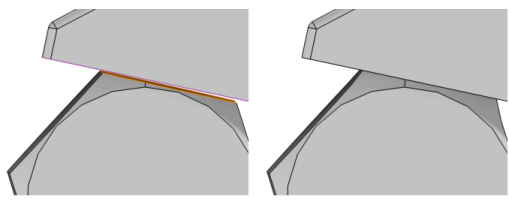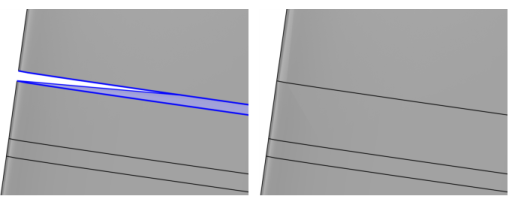To use the operation, in the Geometry toolbar, from the
Virtual Operations menu (

), select
Merge Faces (

). Then enter the properties of the operation using the following sections:
Use the setting Pairing of faces to keep and remove to specify how to input the faces to merge. Select
Automatic (default) to select all faces to merge in one list and let the software decide which faces to keep and which faces to remove. Select
Manual to manually select the faces to keep and then select the faces to remove, using the sections below.
For Pairing of faces to keep and remove set to
Automatic, click the
Active button to toggle between turning ON and OFF the
Faces to merge selection. Select the faces that you want to merge in the
Graphics window or add them from the
Selection List. They then appear in the
Faces to merge list.
For Pairing of faces to keep and remove set to
Manual, click the
Active button to toggle between turning ON and OFF the
Faces to keep selection. Select the faces that you want to keep in the
Graphics window or add them from the
Selection List. They then appear in the
Faces to keep list. Then, click the
Active button to toggle between turning ON and OFF the
Faces to remove selection. Select the faces that you want to remove in the
Graphics window or add them from the
Selection List. They then appear in the
Faces to remove list.
Use the setting Maximum distance setting to specify the maximum distance to bridge when merging faces in the geometry. Choose
Relative to enter a value in the
Relative distance field. This value is relative to the length of the longest side of the geometry’s bounding box. Select
Absolute to specify a value in the
Absolute distance field. When the operation is built with the setting
Automatic (the default), the value in the
Absolute distance field is automatically updated to correspond to the actually used distance. The automatic tolerance is based on the size of the bounding box of the mesh.
Select the checkbox Force one-to-one to force the faces on the remove side to be matched with the keep side without any imprints. This is useful when the shape is approximately the same and you want to match them exactly. Note that if the faces have too different shape, the merge will generally not be successful with this option.
Use the Method setting to specify the way to match a determined pair of faces to keep and remove. The method
Make imprints means that the faces to keep make an imprint on the faces to remove and, symmetrically, the faces to remove make an imprint on the faces to keep. Then, only the overlapping imprints are merged. This is shown in
Figure 7-97.

Use the Precision field or slider to specify the accuracy of the imprint. A low precision will give a sloppier matching, meaning that face regions with approximately the same shape will be matched without imprinting, while high precision gives a more accurate imprint but also means that small faces and details can appear.
The method One-to-one forces the faces to remove to be matched with the keep side without any imprints. This is useful when the shape is approximately the same and you want to match them exactly. Note that if the faces have too different shape, the merge will generally not be successful with this option.
The Create domains checkbox is selected by default to create domains from watertight void regions. If you do not want or need domains, clear this checkbox.


